Digital controller for medium-low temperature
refrigeration applications
XW60LH
1. GENERAL WARNING....................................................................................................................1
2. GENERAL DESCRIPTION ............................................................................................................1
3. CONTROLLING LOADS ................................................................................................................1
4. FRONT PANEL COMMANDS .......................................................................................................1
5. MAX & MIN TEMPERATURE MEMORIZATION ..........................................................................2
6. MAIN FUNCTIONS ........................................................................................................................2
7. PARAMETERS...............................................................................................................................2
8. DIGITAL INPUTS ...........................................................................................................................4
9. TTL SERIAL LINE – FOR MONITORING SYSTEMS ...................................................................4
10. X-REP OUTPUT – OPTIONAL ......................................................................................................4
11. INSTALLATION AND MOUNTING ................................................................................................4
12. ELECTRICAL CONNECTIONS .....................................................................................................4
13. HOW TO USE THE HOT KEY .......................................................................................................4
14. ALARM SIGNALS ..........................................................................................................................4
15. TECHNICAL DATA ........................................................................................................................5
16. CONNECTIONS .............................................................................................................................5
17. DEFAULT SETTING VALUES .......................................................................................................5
1. GENERAL WARNING
1.1 PLEASE READ BEFORE USING THIS MANUAL
• This manual is part of the product and should be kept near the instrument for easy and quick
reference.
• The instrument shall not be used for purposes different from those described hereunder. It cannot be
used as a safety device.
• Check the application limits before proceeding.
• Dixell Srl reserves the right to change the composition of its products, even without notice, ensuring
the same and unchanged functionality.
1.2
SAFETY PRECAUTIONS
• Check the supply voltage is correct before connecting the instrument.
• Do not expose to water or moisture: use the controller only within the operating limits avoiding sudden
temperature changes with high atmospheric humidity to prevent formation of condensation
• Warning: disconnect all electrical connections before any kind of maintenance.
• Fit the probe where it is not accessible by the End User. The instrument must not be opened.
• In case of failure or faulty operation send the instrument back to the distributor or to “Dixell S.r.l.” (see
address) with a detailed description of the fault.
• Consider the maximum current which can be applied to each relay (see Technical Data).
• Ensure that the wires for probes, loads and the power supply are separated and far enough from each
other, without crossing or intertwining.
• In case of applications in industrial environments, the use of mains filters (our mod. FT1) in parallel
with inductive loads could be useful.
• Dixell Srl reserves the right to change the composition of its products, even without notice, ensuring
the same and unchanged functionality.
2. GENERAL DESCRIPTION
Model XW60LH, format 38x185mm, is microprocessor based controller, suitable for applications on
medium or low temperature ventilated refrigerating units. It has 4 relay outputs to control compressor,
fan, defrost, which can be either electrical or reverse cycle (hot gas) and a fourth configurable output.
They could be provided with a Real Time Clock which allows programming of up to 6 daily defrost
cycles, divided into holidays and workdays. A “Day and Night” function with two different set points is
fitted for energy saving. They are also provided with up to four NTC or PTC probe inputs, the first one
for temperature control, the second one, to be located onto the evaporator, to control the defrost
termination temperature and to managed the fan. One of the digital inputs can operate as third
temperature probe. The fourth probe is used to signal the condenser temperature alarm or to display
a temperature.
The HOT KEY output allows to connect the unit, by means of the external module XJ485-CX, to a
network line ModBUS-RTU compatible such as the dIXEL monitoring units of X-WEB family. It
allows to program the controller by means the HOT KEY programming keyboard.
The instrument is fully configurable through special parameters that can be easily programmed
through the keyboard.
3. CONTROLLING LOADS
3.1 COMPRESSOR
The regulation is performed according
to the temperature measured by the
thermostat probe with a positive
differential from the set point: if the
temperature increases and reaches
set point plus differential the
compressor is started and then turned
off when the temperature reaches the
set point value again.
In case of fault in the thermostat probe the start and stop of the compressor are timed through
parameters Con and CoF.
3.2 DEFROST
Two defrost modes are available through the tdF parameter: defrost through electrical heater (tdF =
EL) and hot gas defrost (tdF = in).
The defrost interval depends on the presence of the RTC (optional). If the RTC is present is
controlled by means of parameter EdF:
- EdF=in: a defrost starts after elapsing the idF time (standard way for controller without RTC).
EdF=rtC: defrosts are scheduled by using a real time clock system, depending on the hours set in
the parameters Ld1..Ld6, during workdays, and in Sd1…Sd6 during holidays.
Other parameters are used to control defrost cycles: its maximum length (MdF) and two defrost
modes: timed or controlled by the evaporator’s probe (P2P).
At the end of defrost dripping time is started, its length is set in the Fdt parameter. With Fdt=0 the
dripping time is disabled.
3.3 CONTROL OF EVAPORATOR FANS
The fan control mode is selected by means of the FnC parameter:
- FnC=C_n: fans will switch ON and OFF with the compressor and not run during defrost;
- FnC=o_n: fans will run even if the compressor is off, and not run during defrost;
- FnC=C_Y: fans will switch ON and OFF with the compressor and run during defrost;
- FnC=o_Y: fans will run continuously also during defrost.
After defrost, there is a timed fan delay allowing for drip time, set by means of the Fnd parameter.
An additional parameter FSt provides the setting of temperature, detected by the evaporator probe,
above which the fans are always OFF. This is used to make sure circulation of air only if his
temperature is lower than set in FSt.
3.3.1 Forced activation of evaporator fans
This function, managed by the FCt parameter, is designed to avoid short cycles of evaporator fans,
which could happen when the controller is switched on or after a defrost (when the room air warms
the evaporator). If the temperature difference between the evaporator and the room probes is higher
than the value set in the FCt parameter the fans are switched on. With FCt=0 this function is
disabled.
3.3.2 Fans cyclic activation with compressor off.
When FnC=C-n or C-Y (fans working in parallel with the compressor), by means of the Fon and FoF
parameters the fans can carry out on and off cycles even if the compressor is switched off. When the
compressor is stopped the fans go on working for the Fon time. With Fon=0 the fans remain always
off, when the compressor is off.
3.4 AUXILIARY OUTPUT CONFIGURATION
The functioning of the auxiliary relay can be set by the oAx parameters according to the kind of
application. In the following paragraph the possible settings are explaided.
3.4.1 Auxiliary thermostat
A possible use is the anti condensing heater, with the possibility of switching it on and off also by
keyboard.
Parameters involved:
- ACH: kind of regulation for the auxiliary relay: Ht: heating; cL: cooling;
- SAA: set point for auxiliary relay;
- SHy: differential for auxiliary relay;
- ArP: probe for auxiliary relay;
- Sdd: auxiliary output off during defrost.
The differential is given by the SHy parameter.
The auxiliary relay can be switched on also by using the AUX button. In this case it remains on till it’s
manually switched off.
NOTE: If oAx=AUS and ArP=nP (no probe for auxiliary output), the AUX relay can be activated only
by pushing the AUX button of the keyboard.
3.4.2 On/off relay – oAx = onF
In this case the relay is activated when the controller is turned on and de-activated when the
controller is turned off.
3.4.3 Neutral zone regulation
With oAx=db the AUX relay can control a heater element to perform a neutral zone action.
- output oAx cut in = SET-HY;
- output oAx cut out = SET.
3.4.4 Second compressor
With oAx=CP2, the AUX relay operates as second compressor: it is activated in parallel with the
relay of the first compressor, with a proper activation delay (set in the AC1 parameter). Both the
compressors are switched off at the same time.
3.4.5 Alarm relay
With oAx=ALr the AUX relay operates as alarm relay. It is activated every time an alarm happens.
Its status depends on the tbA parameter:
- tbA=Y: the relay is silenced by pressing any key;
- tbA=n: the alarm relay remains on until the alarm condition recovers.
3.4.6 Night blind management during energy saving cycles
With oAx=HES the AUX relay operates to manage the night blind: the relay is energised when the
energy saving cycle is activated by digital input, frontal button or RTC (optional).
4. FRONT PANEL COMMANDS
To display target set point; in programming mode it selects a parameter or
confirm an operation.
(DEF) To start a manual defrost.
(UP) To see the max stored temperature; in programming mode it browses the
parameter codes or increases the displayed value.
(DOWN) To see the min stored temperature; in programming mode it browses
the parameter codes or decreases the displayed value.
(OFF) To switch the instrument off, if onF=oFF.
(LiG) To switch the light, if oA3=Lig.
1592036000 XW60LH GB r1.0 18.03.2015 XW60LH 1/6
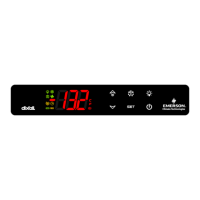
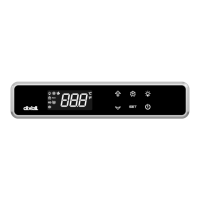
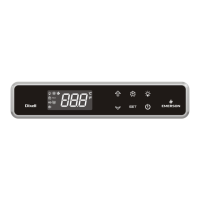
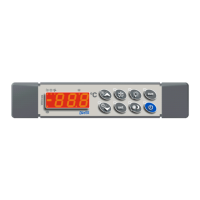

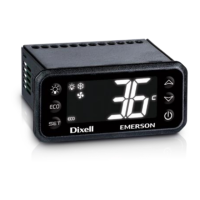
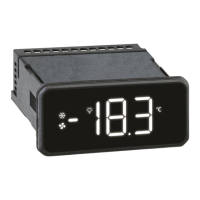


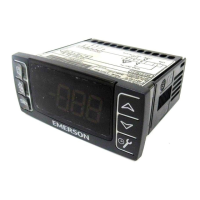
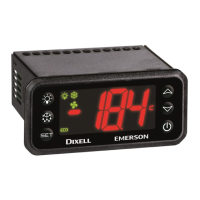
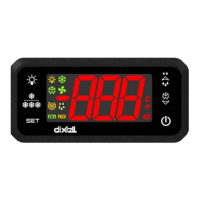
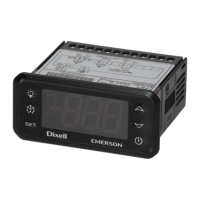
